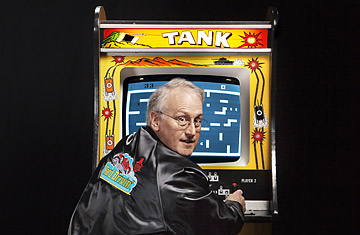
Lyle Rains, Tank. His 1974 multi-joystick game rolled out several sequels. His new target: Angry Birds.
(3 of 4)
Innovative Leisure will formally announce its existence on Feb. 9 at the annual DICE summit (Design, Innovate, Communicate, Entertain--the Davos of the gaming world) in Las Vegas. Tickets are $2,200 a pop, and pretty much every CEO in the industry will be there. The Academy of Interactive Arts and Sciences (AIAS), which puts on the super-high-end conference, asked Seamus & Co. to be this year's keynote speakers. "These Atari guys are heroes. They're the all-stars," says the academy's president, Martin Rae. "I think they have a great shot at making something really fun and compelling."
Ka-boom!
The company has hired ten interns straight out of USC's computer-science department to help the Atari old-timers use new tools to crank out prototypes for games in less time than it used to take to code an impressive ka-boom! "Back in the day," says Merritt, who designed Atari's multidirectional shooter Black Widow in 1982, "we all would spend weeks working on a game effect, maybe only a few seconds long, that would amaze and overwhelm the others and would make them say, 'I didn't realize you could do this with that hardware.'" Effort that all came to naught, he hastens to add, if the rest of the team judged the effect to be unfun.
All told, there is a staff of 30 working to release seven original games in 2012, which is the size and pace of Atari circa 1978. Game publisher THQ has green-lighted every idea the company has pitched so far. Of the various titles under development, the one most likely to, in Blackley's estimation, "save the planet" or at least break new ground is a game code-named WW1 Dogfight. It is a fighting-game app that, as one might expect, pits two biplanes against each other over the skies of Europe. But what's novel about the setup in this turn-based game is that you and your opponent don't have to be playing at the same time. You can make a move by picking from a menu of choices (fly left, right, straight ahead) while waiting in line at the grocery store. And your opponent might react--perhaps by choosing a more complicated maneuver, like a wingover or an Immelman--only after she has put the kids to bed. The computer calculates and animates the result. If either player manages to get the other in their sight, the game automatically shoots and adds up the damage before asking both players for their next move. The end result is an epic battle that plays out in spurts, kind of like an action-adventure edition of Words with Friends. And after the Red Baron has been shot out of the sky, you can sit back and watch an instant replay of the whole action sequence.
Turn-based tactical games are not a new concept; chess nerds were snail-mailing one another their moves long before everyone had e-mail. But Blackley believes that adding the element of asynchronicity to the video-game version and putting it on an easy-to-use mobile platform represents a new paradigm in the industry. At the original meeting of the minds at Pebble Beach last summer, no fewer than three of the principals came to the gamestorming session with variations on this idea, which could be applied to other kinds of fighting games or sports games or even games with in-depth story lines. It seems tailor-made for casual gamers with short attention spans.
